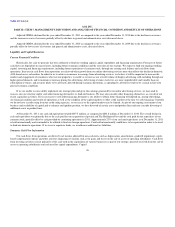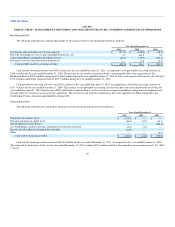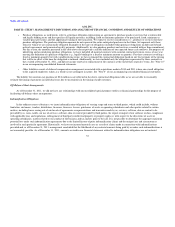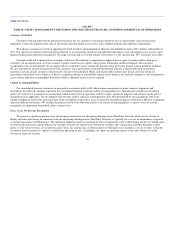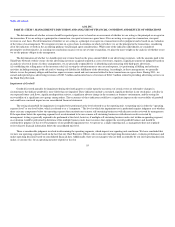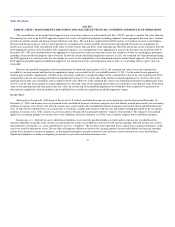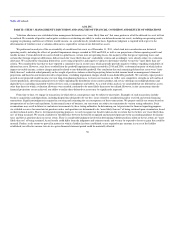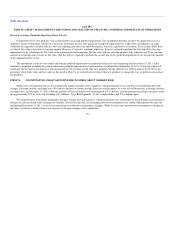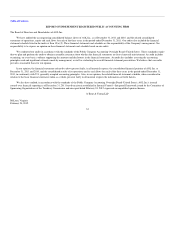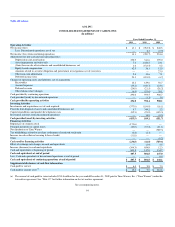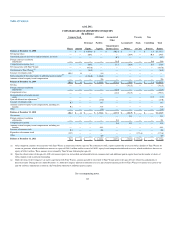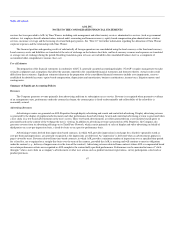America Online 2011 Annual Report Download - page 61
Download and view the complete annual report
Please find page 61 of the 2011 America Online annual report below. You can navigate through the pages in the report by either clicking on the pages listed below, or by using the keyword search tool below to find specific information within the annual report.
Table of Contents
AOL INC.
PART II—ITEM 7. MANAGEMENT'S DISCUSSION AND ANALYSIS OF FINANCIAL CONDITION AND RESULTS OF OPERATIONS
The reasonableness of the market-based approach was assessed by reference to a discounted cash flow ("DCF") measure as another fair value indicator.
Determining fair value using the DCF approach requires the exercise of significant judgment, including judgments about appropriate discount rates, terminal
growth rates and the amount and timing of expected future cash flows. The cash flows employed in the DCF analysis are based on our most recent budgets,
forecasts and business plans as well as various growth rate assumptions for years beyond the current business plan period. Discount rate assumptions are
based on an assessment of the risk inherent in the future revenue streams and cash flows of the reporting unit. Based on the decline in our stock price from the
2010 impairment analysis to the December 2011 impairment analysis, we concluded that it was appropriate to increase the discount rates used from 2010 to
December 2011. We also concluded that it was appropriate to factor into the analysis certain other assets that would be of value to a marketplace participant,
including certain intellectual property and tax benefits. In both the interim and annual impairment analyses in 2011, the estimated fair value determined using
the DCF approach was consistent with, but also slightly in excess of, the estimated fair value determined using the market-based approach. The results of the
DCF approach provided significant additional support for our conclusion that the control premium used to arrive at a controlling interest equity value was
reasonable.
Based on the goodwill impairment analyses performed in the third and fourth quarter of 2011, the estimated fair value of our sole reporting unit
exceeded its carrying amount and therefore no impairment charge was recorded for the year ended December 31, 2011. As the market-based approach is
based in part on market capitalization, volatility in the stock price could have a significant impact on the estimated fair value of the sole reporting unit. If the
estimated fair value of our reporting unit had been hypothetically lower by 5% as of the date of the interim or annual impairment test, the fair value of our
reporting unit in both cases would have still exceeded its book value. However, if the estimated fair value of our reporting unit had been hypothetically lower
by 10% as of the date of the interim or annual impairment test, the book value of our reporting unit in both cases would have exceeded fair value. If the book
value of our reporting unit had been greater than fair value, the second step of the goodwill impairment test would have been required to be performed to
determine the implied fair value of goodwill, and would likely have resulted in a significant goodwill impairment charge.
Income Taxes
Subsequent to the spin-off, AOL began to file its own U.S. federal consolidated income tax return (beginning with the short period December 10 –
December 31, 2009) and income taxes are presented in the consolidated financial statements using the asset and liability method prescribed by the accounting
guidance for income taxes. Prior to the spin-off, income taxes as presented in the consolidated financial statements represented current and deferred income
taxes of Time Warner attributed to us in a manner that is systematic, rational and consistent with the asset and liability method prescribed by the accounting
guidance for income taxes. AOL's income tax provision prior to the spin-off was prepared under the "separate return method." The separate return method
applies the accounting guidance for income taxes to the standalone financial statements as if AOL were a separate taxpayer and a standalone enterprise.
Income taxes (i.e., deferred tax assets, deferred tax liabilities, taxes currently payable/refunds receivable and tax expense) are recorded based on
amounts refundable or payable in the current year and include the results of any difference between GAAP and tax reporting. Deferred income taxes reflect
expected future tax benefits (i.e., assets) and future tax costs (i.e., liabilities). The tax effect of net operating losses, capital losses and general business credit
carryovers result in deferred tax assets. The tax effect of temporary differences between the carrying amount of assets and liabilities for financial statement
and the basis amount for income tax purposes, as determined based upon currently-enacted tax laws and rates, result in deferred tax assets and liabilities.
Significant judgments are made in computing our income tax provision and deferred income taxes.
57



